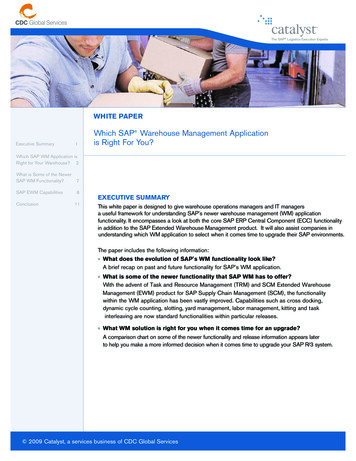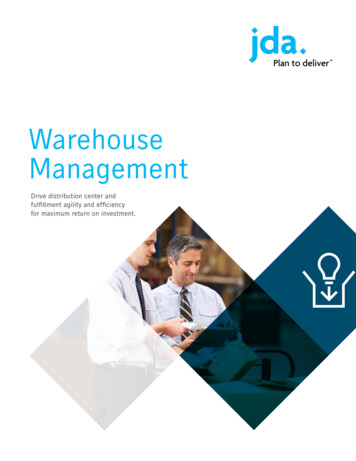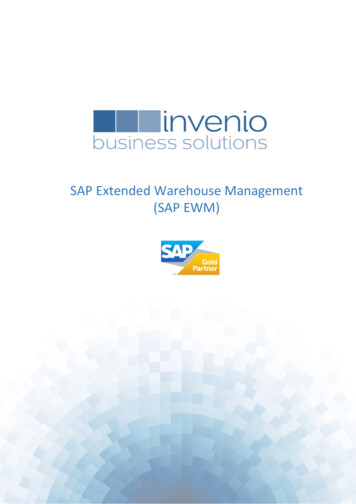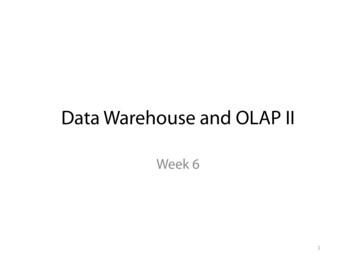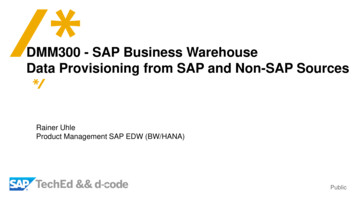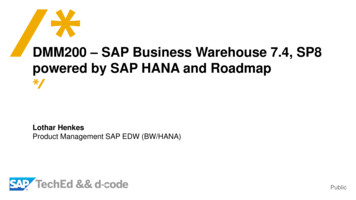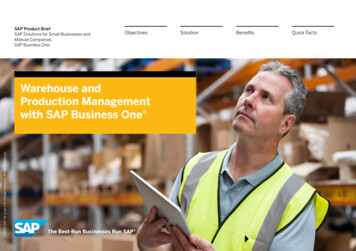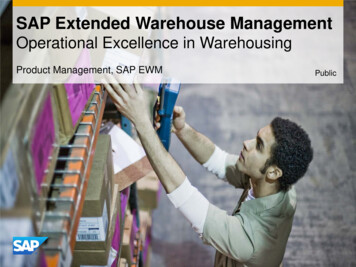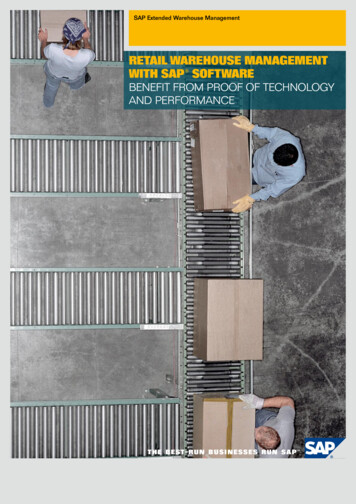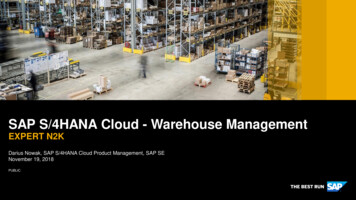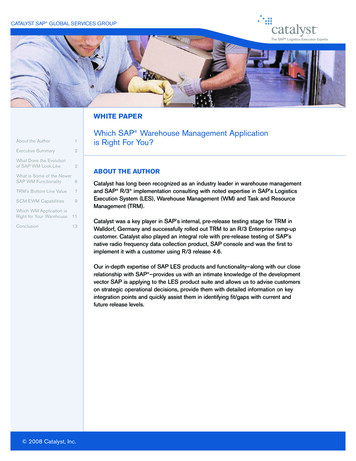
Transcription
CATALYST SAP GLOBAL SERVICES GROUPWHITE PAPERAbout the Author1Executive Summary2What Does the Evolutionof SAP WM Look Like2What is Some of the NewerSAP WM Functionality6TRM’s Bottom Line Value7SCM EWM Capabilities9Which WM Application isRight for Your Warehouse 11Conclusion13Which SAP Warehouse Management Applicationis Right For You?ABOUT THE AUTHORCatalyst has long been recognized as an industry leader in warehouse managementand SAP R/3 implementation consulting with noted expertise in SAP’s LogisticsExecution System (LES), Warehouse Management (WM) and Task and ResourceManagement (TRM).Catalyst was a key player in SAP’s internal, pre-release testing stage for TRM inWalldorf, Germany and successfully rolled out TRM to an R/3 Enterprise ramp-upcustomer. Catalyst also played an integral role with pre-release testing of SAP’snative radio frequency data collection product, SAP console and was the first toimplement it with a customer using R/3 release 4.6.Our in-depth expertise of SAP LES products and functionality—along with our closerelationship with SAP —provides us with an intimate knowledge of the developmentvector SAP is applying to the LES product suite and allows us to advise customerson strategic operational decisions, provide them with detailed information on keyintegration points and quickly assist them in identifying fit/gaps with current andfuture release levels. 2008 Catalyst, Inc.
EXECUTIVE SUMMARYThis white paper is designed to give warehouse operations managers and IT managersa useful framework for understanding SAP’s newer Warehouse Managementapplication functionality. It will also assist companies in understanding which WMapplication to select when it comes time to upgrade their SAP environments.The paper includes the following information: What does the evolution of SAP WM look like?A brief recap on past and future functionality for SAP’s WM application.What is some of the newer functionality that SAP WM has to offer?With the advent of TRM and EWM, the functionality within the WM applicationhas been vastly improved. Capabilities such as cross docking, dynamic cyclecounting, slotting, yard management and task interleaving are now standardfunctionalities within particular releases.What WM solution is right for you when it comes time for an upgrade?A comparison chart on some of the newer functionality and release information to helpyou make a more informed decision when it comes time to upgrade your R/3 system.WHAT DOES THE EVOLUTION OF SAP WM LOOK LIKE?SAP has come a long way in the warehouse management application since itsrelease of the R/2 product. A brief evolution is below:2
SAP Releases by DateR/21990’s.WM was a sub-module within the R/2 system(strong locator system, but not a robust WMS)R/3Version 3.1. 1998Version 4.0B. 5/22/98Version 4.5B. 5/17/1999Version 4.6B. 1/31/2000Version 4.6C. 5/29/2000Version 4.7 xt. 1.1.7/15/2002Version 4.7 xt. 2.0.9/22/2003mySAP ERP 2004 (ECC 5.0). 2005mySAP ERP 2005 (ECC 6.0). 9/1/2006mySAP SCM EWM 5.0.Late 2005/Early 2006mySAP SCM EWM 5.1.Targeted for Q3 2007Functionality built within SAP WM3.X included the following: Storage and Facility Management –manage different batches, stock types(vendor consignment stock, own), andstock status (quality, unrestricted) Warehouse Structure – basic buildingblocks of the warehouse (storagetype, storage sections and bins) Stock Management – mixed andhomogeneous storage possible Material Master Data – addition ofWM fields in MM views Units of Measure – WM unit possibleat WM level SLED Posting Changes – material tomaterial, stock status to stock status Transfer Requirements/TransferOrders – See Appendix A Ability to Post Stock Differences –upon putaway only Fixed Bin Replenishment Putaway Strategies Picking Strategies Storage Unit Management HAZMAT Inbound Material Processing Internal MovementsOutbound Material ProcessingPhysical Inventory Annual Continuous Cycle Count Zero Stock CheckBasic ReportingAuthorizationsArchivingInterfaces Available to ExternalSystems (i.e. RF devices)User Exits AvailableFunctionality built within SAP WM4.0 included the following: Lean WM New Org. Structures such as gates,picked items zone, and pick area Capacity to search up to 30 StorageTypes (previously 10) Number of Storage Unit Typesincreased to 30 (previously 10) Number of Storage Sections searchedincreased to 30 (previously 10) Up to 99 items can be managed in abin with Putaway strategy P(previously 14)3
More than 1 storage location can bewarehouse managed under the samewarehouse number (previously only 1warehouse per storage location andplant was manageable).Pick strategy performance enhanced(active capacity check)WM unit of measure possible atmaterial levelEnhanced stock search (i.e cansearch own stock before vendorconsignment stock)Enhanced storage section searchcapabilityCreate TO for GR from Return StockfunctionalityCustomer Exit available forReplenishmentsPlanned TO times – used for thebasis of workload calculation andincentive wageTO Splitting – balance workloadbetween usersAbility to change a TRAbility to process posting changescompletely in WMEnhanced putaway strategy K and Bulkputaway (ability to block from furtherstock placements to ensure FIFO)Ability to process QM samples in thebackground2 Step PickingEnhanced strategy M through roundingquantities on the material master calls a customer exit forStringent FIFOPre-picked shipping unitsFree PackingPlanning and Monitoring ToolsPicking WavesRough Workload Estimator WAM (warehouse activity monitor)Physical Inventory Changes – monetarylimits can be set for recountsQuantity reductionDisplay material texts with ReleaseOrder Parts StagingFunctionality built within SAP WM4.5A included the following: New component added (LES) vs. WM dWM (Decentralized WarehouseManagement) available KANBAN capabilities Destination bin changeable uponputaway TO confirmation Ability to close out TR’s (i.e. setdelivery complete) TO processing comment added Basic pre-allocated stock crossdocking (hot list) Inbound delivery becomes available Ability to putaway stock that wasincorrectly picked on a delivery Enhanced picking reports Enhanced HAZMAT processing Physical inventory enhanced –inspection lot processingFunctionality built within SAP WM4.6A/B included the following: Ability to suppress differences inconfirming TO’s Two-step TO confirmation possible Native RF capabilities RF Monitor available Enhanced dWM capabilities Use of Enjoy transactions (LS01 toLS01N) make transactions easier to use Reports converted to ABAP ListViewer (ALV) – gives the user theability to sort, sum, etc.4
Functionality built within SAP WM4.6C included the following: Added additional SAP console (RF)transactions and fixed many bugs Ability to create a replenishment TOautomatically Handling Unit Functionality Physical Inventory Changes –counting at quant level possible Basic interleaving possible Enhancements to dWM – postingchanges initiated from dWM, deliverysplit Proof of Delivery functionality Packing StationFunctionality built within SAP WM4.7 xt. 1.1 included the following: 1 TO possible for multiple deliveries Partial GR for an IBDN possible TRM (Task and ResourceManagement) introduced Data changes to dWM can be timed Several ERP systems can be tied toa single dWM instanceFunctionality built within SAP WM4.7 xt. 2.0 included the following: Support for DSD (Direct StoreDelivery) Planned and Opportunistic CrossDocking functionality Value Added Services Yard Management Dynamic Cycle Counting TRM enhancements (Log monitor,capacity checks at the node level) RF serial number capture possible onthe DeliveryFunctionality built within mySAP ERP2004 (ECC 5.0) or mySAP ERP 2005(ECC 6.0) includes the following: Advanced Transportation Planningand Vehicle Scheduling using APO Direct Store Delivery enhancements Archiving enhancements Progress Confirmation of jobs(background status update every 30min, foreground every 10 seconds) WCU (Warehouse Control Unit) –controls automation of warehousedevices; optimized when used inconjunction with TRMFunctionality built within mySAPSCM EWM 5.0 includes thefollowing: Slotting Rearrangement Transportation Cross Docking Tight EH&S Integration Enhanced Customer Returns –requires CRM Kit to Order – requires CRM HUM activated at the Storage TypeLevel Serial Number Enhancement – cantrack SN to a bin without needing anHU Storage type and section now 4 digits Bin name is now 18 digits Material Flow Systems support5
WHAT IS SOME OF THE NEWER SAP WM FUNCTIONALITY?TRM offers uniquefeatures for optimizedmaterials movement, atransparent view ofwarehouse processesand value addedservices support.With TRM’s support forvalue added services,you can easily labelgoods or accommodatecustomers’ specialpackaging requests.Task and Resource ManagementAs of SAP release 4.7, TRM strengthens and completes the LES/WM solution byoptimizing material flows via task execution and resource deployment. TRM breaksdown material movements to a task and resource level and optimizes the sequencein which they are executed, ensuring that the right task is completed by the bestresource at the most optimal time.TRM helps you to manage your warehouse processes more efficiently because itachieves an unparalleled degree of process visibility within the system by trackingany activity performed on the warehouse floor. TRM uses a systemic model of thewarehouse’s physical layout to deploy resources according to the actual workload,the resource’s qualifications and the current geographic positions of the resources.The efficient deployment of resources contributes to a considerable reduction ofcosts in material flow processing.TRM Features Task Execution Prioritization Interleaving Value Added Services Tracking andMonitoringBottom line, TRM willoptimize your supplychain management,improve your customerand partner relations andprovide cost savings.SAP WM and TRM are closely integrated and work hand-in-hand to manage andmaintain the workload in warehouses. WM provides the movement, operationdemands, high-level scheduling and planning. TRM distributes the work among thevarious resources.6
TRM’S BOTTOM LINE VALUETRM’s ability to optimize resource deployment, material flow, routing and processvisibility enables an accelerated supply chain, which in turn leads to improvedcustomer service, better partner relations and overall cost savings.7
Extended Warehouse ManagementExtended Warehouse Management (EWM) was released with SAP’s Supply ChainManagement module (SCM). The terminology can be confusing, but there are reallytwo different forms of EWM, depending on how they are being used. When SAPWarehouse Management is being used with SAP release ECC 5.0 or higher, in thecentralized mode, it is referred to as ERP EWM. When SAP WM is being used inthe decentralized form in conjunction with the SCM module, it is referred to asSCM EWM. In it’s decentralized form, the capabilities of EWM are expanded.Basically, ERP EWM is little changed from the functionality that exists in SAP 4.7.With SCM EWM, the functionality includes what 4.7 xt. 2.0 can do as well asimproved workflow, process integration and the various other features mentionedabove (under evolution).SCM EWM offers increased flexibility and capabilities beyond ERP EWM. Typically,SCM is tailored to organizations who have high SKU and line item volumes, veryfast moving product, complex cross docking requirements, detailed packaging andshipping processes, and third party logistics services (3PL) on either the Inbound orOutbound side, or both.The following table represents the various types of SAP Warehouse Managementthat are available for each release. You can see that there is a migration towardsSCM EWM.SCM EWM CAPABILITIES8
Inherently, SCM EWM should operate on a decentralized server. This is designed inthis matter for maximum performance and flexibility. Periodically, you will seereferences to the Service Parts industry, as this industry made the first use out ofthis solution; however, SCM is designed to work across multiple industries. It alldepends on the functionality and business requirements that your organizationneeds to meet. This is discussed in more detail in the next section.Within SCM 5.0, the module is split into two sections:Service Parts Planning Strategic Supply Chain Design Parts Demand Planning Parts Inventory Planning Parts Supply Planning Parts Distribution Planning Parts Monitoring Supply Network Collaboration Supply Chain AnalyticsService Parts Execution Quality Assurance and Control Warehousing and Storage Physical Inventory Cross Docking Outbound Processing Transportation Management Execution Monitoring Execution Collaboration AnalyticsMinimum ArchitectureThe following minimal architecture is required to run SAP SCM EWM: SAP CRM 5.0 SAP SCM 5.0 SAP GTS 7.0 Plug in basis 2005.1 ECC 6.0 (mySAP ERP 2005) – see note below SAP Netweaver 2004sNOTE: For SAP SCM EWM - Service Pack 6 supports connections (through IDOCsand Bapis vs. qRFC) to releases from 4.6c to mySAP ERP 2004 (ECC 5.0), but fullfunctionality does not exist9
FunctionalityMany of the underpinnings of TRM have been incorporated into the SCM EWMproduct (such as Tasks, Resources, 3-dimensional warehouse, etc). Like TRM,SCM EWM should use Handling Units to move and track stock in the facility. SAPhas enhanced the use of Handling Units within the warehouse to make them easierand more flexible to use compared to previous releases. Other funct
centralized mode, it is referred to as ERP EWM. When SAP WM is being used in the decentralized form in conjunction with the SCM module, it is referred to as SCM EWM. In it’s decentralized form, the capabilities of EWM are expanded. Basically, ERP EWM is little changed from the functionality that exists in SAP 4.7. With SCM EWM, the functionality includes what 4.7 xt. 2.0 can do as well as .
